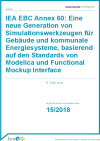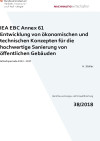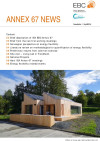Suchergebnisse
IEA EBC Annex 71: DYNASTEE Newsletter 2017/9

Der Verein DYNASTEE (DYNamic Analysis Simulation and Testing applied to the Energy and Environmental performance of buildings), beschäftigt sich mit der Charakterisierung von Gebäuden. Der aktuelle Newsletter widmet sich unter anderem der Sommerschule 2018, der Untersuchung von Identifizierungs- und Charakterisierungsmethoden sowie In-situ Messungen und CEN bzw ISO Normung.
Herausgeber: DYNASTEE
Englisch, 4 Seiten
Downloads zur Publikation
IEA EBC Annex 60: Eine neue Generation von Simulationswerkzeugen für Gebäude und kommunale Energiesysteme, basierend auf den Standards von Modelica und Functional Mockup Interface

Ziel des Annexes war die Entwicklung von Simulations- und Berechnungswerkzeugen der nächsten Generation, die es ermöglichen, dass Gebäude und kommunale Energiesysteme als integrierte Systeme konzipiert und betrieben werden können. Die im Annex durchgeführten Arbeiten haben dazu beigetragen Open-Source-Software von bisher unkoordinierten Aktivitäten im Bereich der Modellierung und Simulation auf Basis der Standards von Modelica und Functional Mockup Interface weiterzuentwickeln und einzusetzen.
Schriftenreihe
15/2018
E. Widl, et al.
Herausgeber: bmvit
Deutsch, 49 Seiten
Downloads zur Publikation
IEA EBC Annex 61 - Entwicklung von ökonomischen und technischen Konzepten für die hochwertige Sanierung von öffentlichen Gebäuden

Inhalt ist die Entwicklung von technischen und ökonomischen Konzepten für die hochwertige Sanierung von öffentlichen Gebäuden. Um hochwertige, energieeffiziente Sanierungen zu forcieren, liegt ein Schwerpunkt auch in der Entwicklung von alternativen Finanzierungsmodellen (Energie-Contracting). Neben Studien und Analysen bereits umgesetzter Sanierungsprojekte steht auch ein Ratgeber für Entscheidungsträger und Contracting Firmen bereit.
Schriftenreihe
38/2018
H. Staller
Herausgeber: BMVIT
Deutsch, 75 Seiten
Downloads zur Publikation
IEA Joint Project SHC Task 40/EBC Annex 52 Internationale Definition von Nullenergiegebäuden
Das Ziel dieses Projekts war es, eine international harmonisierte Methodik und ein gemeinsames Verständnis für Netto-Null-Energiegebäude zu erarbeiten. Netzintegrierte Null- oder Plus-Energiegebäude sind energieeffiziente Gebäude, die durch vor Ort erneuerbar produzierte Energie ausgeglichen bilanzieren oder Energie in Wärme- oder Stromnetze einspeisen.
IEA EBC Annex 71: DYNASTEE Newsletter 2018/11

DYNASTEE steht für „DYNamic Analysis Simulation and Testing applied to the Energy and Environmental performance of buildings“.Die informelle Gruppierung beschäftigt sich mit dem Thema Charakterisierung von Gebäuden.
Herausgeber: DYNASTEE
Englisch, 4 Seiten
Downloads zur Publikation
IEA EBC Annex 71: DYNASTEE Newsletter 2019/12

DYNASTEE steht für „DYNamic Analysis Simulation and Testing applied to the Energy and Environmental performance of buildings“. Die informelle Gruppierung beschäftigt sich mit dem Thema Charakterisierung von Gebäuden.
Herausgeber: DYNASTEE
Englisch, 4 Seiten
Downloads zur Publikation
IEA EBC Annex 71: DYNASTEE Newsletter 2019/13

DYNASTEE steht für „DYNamic Analysis Simulation and Testing applied to the Energy and Environmental performance of buildings“. Die informelle Gruppierung beschäftigt sich mit dem Thema Charakterisierung von Gebäuden.
Herausgeber: DYNASTEE
Englisch, 4 Seiten
Downloads zur Publikation
Lösungsansätze für die bewohnte Baustelle - IEA ANNEX 50 (Fischer/Schwehr/Zimmermann, 4/2007)

Deutsch
IEA EBC Annex 71: DYNASTEE Newsletter 2018/10

DYNASTEE steht für "DYNamic Analysis Simulation and Testing applied to the Energy and Environmental performance of buildings", eine informeller Verein welcher sich mit dem Thema Charakterisierung von Gebäuden beschäftigt. DYNASTEE gibt halbjährlich einen Newsletter heraus.
Herausgeber: DYNASTEE
Englisch, 4 Seiten
Downloads zur Publikation
IEA EBC Annex 91: Open BIM für Energieeffiziente Gebäude
Building Information Modeling (BIM) gilt als Schlüsseltechnologie zur Optimierung der Gesamtenergieeffizienz von Gebäuden. Im Projekt werden die Grundlagen dafür geschaffen, dass OpenBIM Tools zukünftig auch die Bewertung und Optimierung der Energieeffizienz von Gebäuden beinhalten, Open BIM-Prozesse und Datenmodelle verstärkt harmonisiert und standardisiert werden und damit zukünftig auch kleinere Baufirmen die Möglichkeit haben, in komplexen BIM-Projekten mitzuarbeiten.
IEA EBC Annex 91: Open BIM for Energy Efficient Buildings
Building Information Modeling (BIM) is considered a key technology for optimising the overall energy performance of buildings. The project lays the foundations for OpenBIM tools to include the assessment and optimisation of the energy efficiency of buildings in the future, for Open BIM processes and data models to be increasingly harmonised and standardised, and thus for smaller construction companies to have the opportunity to work on complex BIM projects in the future.
IEA EBC Annex 89: Wege zur Implementierung von Gebäuden mit Netto-Null-Emissionen
Der IEA EBC Annex 89 konzentriert sich auf Wege und Maßnahmen, die erforderlich sind, um die Netto-Null-Emissionen von Treibhausgasen von Gebäuden auf der Grundlage des gesamten Lebenszyklus in Richtlinien zu verankern und damit in der Praxis umzusetzen. Darüber hinaus unterstützt der Annex 89 auch die strategischen Ziele des EBC-Programms, gerade im Hinblick auf eine konsistente, umfassende Treibhausgasbilanzierung. Annex 89 unterstützt die wichtigsten Stakeholder und Entscheidungsträger:innen bei der Entwicklung und Umsetzung effektiver, mit den Pariser Zielen kompatibler, Konzepte und Lösungen um NetZ-WLC-Gebäude auf mehreren Ebenen zu erreichen.
IEA EBC Annex 89: Ways to Implement Net-zero Whole Life Carbon Buildings
IEA EBC Annex 89 focuses on the pathways and actions needed by various stakeholders and decision-makers to implement whole life cycle based net-zero greenhouse gas (GHG) emissions from buildings in policy and practice. Annex 89 will support key stakeholders and decision-makers in developing and implementing effective Paris-goal compatible schemes and solutions to achieve NetZ-WLC buildings at multiple scales.
IEA EBC Annex 67: Newsletter No. 4, Oktober 2017

Inhalte des Newsletters sind eine Rückschau auf das fünfte Projekttreffen und ein öffentliches Seminar in Wien, ein Artikel über die österreichische Perspektive auf die Energieflexibilität, Entwicklungen rund um den „Smartness Indicator“ der EU, interessante neue Projekte in Dänemark und Frankreich, ein Laborüberblick für Tests zur Energieflexibilität, das Testlabor von AEE INTEC in Gleisdorf, ein Überblick über aktuelle Artikel und Veranstaltungen für 2018.
Søren Østergaard Jensen, DTI
Herausgeber: IEA-EBC Programm
Englisch, 8 Seiten
Downloads zur Publikation
IEA EBC Annex 67: Newsletter 1, April 2016

Inhalt des Newsletters sind eine Kurzbeschreibung des Annex 67, eine Rückschau auf die ersten beiden Projekttreffen, eine Literaturbesprechung und Inhalte der Norwegischen Beteiligung sowie kommende Veranstaltungen.
Søren Østergaard Jensen
Herausgeber: DTI, IEA-EBC Programm
Englisch, 8 Seiten
Downloads zur Publikation
IEA EBC Annex 73: Hin zu resilienten öffentlichen "Niedrigstenergie"-Gebäudeverbänden und Siedlungen
Öffentliche Gebäudeverbände wie Krankenhäuser und Bildungseinrichtungen beherbergen oft kritische Infrastruktur, die auf ausreichende Versorgung mit Energie angewiesen ist. Ziel des Annex war die Entwicklung von Werkzeugen für den Planungsprozess von resilienten, effizienten und emissionsarmen Energiesystemen für solche Gebäudeverbände.
IEA EBC Annex 73: Towards Net Zero Energy Resilient Public Communities
Public buildings such as hospitals and educational institutions often house critical infrastructure that depends on sufficient energy and resource supply. The aim of the annex was to develop tools for the planning process of resilient, efficient and low-emission energy systems for such building clusters.
IEA EBC Annex 70: Energie-Epidemiologie – Analyse des tatsächlichen Energieverbrauchs in Gebäuden
Im Rahmen des IEA-EBC Annex 70 wurden Ursachen über Abweichungen errechneter zu tatsächlicher Energieverbräuche in Gebäuden empirisch untersucht und Anforderungen an die Datenqualität, -charakteristik oder -sicherheit erarbeitet. Weiters wurden Empfehlungen hinsichtlich der Verwendung international einheitlicher Standards und Methoden der Datenerhebung, -aufbereitung und -auswertung entwickelt.
IEA EBC Annex 70: Building Energy Epidemiology: Analysis of Real Building Energy Use at Scale
Within the framework of the IEA-EBC Annex 70, causes of deviations between calculated and actual energy consumption in buildings were empirically investigated and requirements for data quality, characteristics and security were developed. Furthermore, recommendations were developed regarding the use of internationally uniform standards and methods for data collection, processing and evaluation.
EBC News Issue 65: Juni 2017 veröffentlicht!
Der Newsletter stellt Aktivitäten des EBC-Programms vor: Schwerpunktthemen sind Energieeffizienz und Treibhausgasemissionen im Bausektor.
